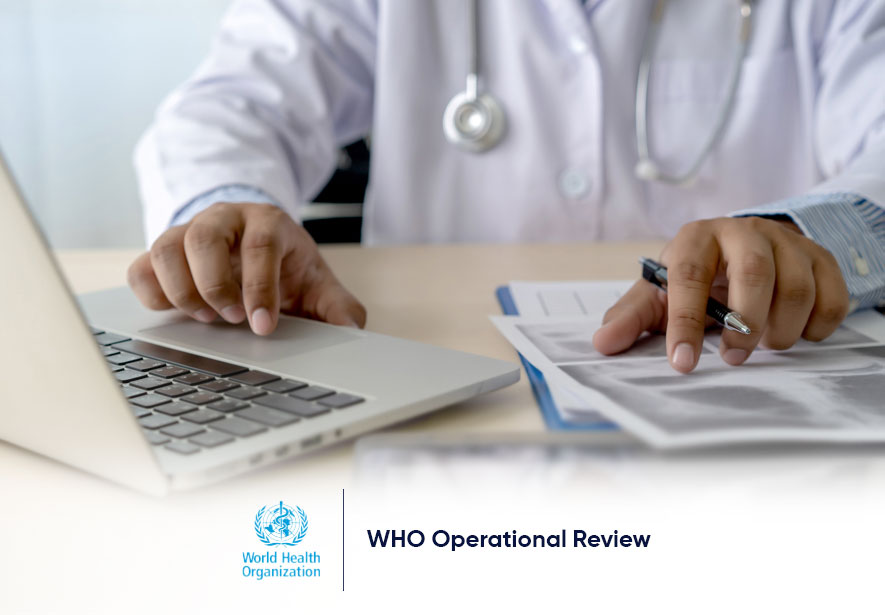
Success Stories
The Evolution of Digital Prescribing with Central e-Prescription
Consider a healthcare case where medication errors are common and treatment plans can be based on guesswork rather than precise medication formulas. Unfortunately, this reflects the reality we all have experienced over the years of outdated prescribing models. Now imagine a solution and system meticulously formulated for accuracy, efficiency and the well-being and safety of patients. Welcome to the reality of Tiga Healthcare Technologies' Central e-Prescription System, where innovation reshapes digital prescription management.
Now let's look at what the traditional prescribing models can cost. These models have caused significant disruptions in patient care and healthcare workflows. Manual processes often lead to delays, miscommunications and errors, affecting treatment timeliness and accuracy. Sadly, these inefficiencies interrupt patient care and pose health risks. A staggering statistic from the World Health Organization is that over 50% of healthcare harm is preventable, with half resulting from incorrect medications.
Another reason for the transition to the digital prescribing model is the increase in chronic diseases and aging populations. The shift from traditional paper-based systems to advanced electronic prescribing significantly enhances precision, reduces errors and advances care quality against these increased threats.
Moreover, electronic prescribing models concern humanity's responsibility towards the environment. Electronic prescribing eliminates the need for physical prescriptions, reducing paper waste and its environmental impact. Digital systems also optimize supply chains and medication management, decreasing overproduction and pharmaceutical waste. By adopting sustainable prescribing practices, healthcare systems can make a significant contribution to environmental conservation while maintaining high standards of patient care.
In this success story, let's spotlight the remarkable achievements of our Central e-Prescription System and the exceptional journey that upgraded it from a 'narcotic prescription system' to a comprehensive system tracking all prescription drugs. We'll delve into the traditional prescribing problems and then showcase the transformative benefits we bring to digital prescription technologies.

The Problem: Challenges of Traditional Prescriptions
For decades, the way we prescribe medications has relied on traditional methods. Unfortunately, it remains outdated in today's conditions. Rising inefficiencies, medication errors and environmental concerns reveal the limitations of traditional prescriptions. The call for digitalization is rising, promising a more integrated and efficient system for optimal patient care. Let's look at these challenges more deeply to understand the need for change.
Inefficiencies in the Healthcare System
Manual tasks throughout the prescription process, such as writing, filling, refilling and dispensing medications, create bottlenecks that slow everything down. This inefficiency wastes valuable time and resources for physicians, prescribers and pharmacists, shifting their focus from patient care. As a result, patients experience longer wait times and healthcare providers shoulder a heavier administrative burden.
As a specific example, illegible handwriting in traditional prescriptions often leads to misconceptions, resulting in medication errors. These errors can compromise patient safety by causing incorrect dosages or even the wrong medication to be dispensed. Thus, the lack of clarity and consistency poses a significant risk, highlighting the need for more reliable and electronic prescribing systems.

Increased Risk of Medication Errors
Manuality is prone to human error and calculations for dosages are no exception. These calculation mistakes have serious consequences for patient safety, such as underdosing or overdosing; both have the potential to cause ineffective treatment or even toxicity.
The risk of manual dosage calculations can be further compounded by the danger of misidentification of potential drug interactions. Most prescriptions contain multiple medications; thus, the potential for adverse reactions and complications grows significantly.
Perhaps the biggest drawback of the traditional prescribing process is the lack of a robust monitoring and control system, making error detection more difficult. This vulnerability can contribute to the abuse of narcotics and psychotherapeutics. For instance, handwritten prescriptions are much easier to alter and refills can be manipulated more easily. Implementing electronic prescribing systems with secure and trackable prescriptions provides greater management over the prescribing and dispensing of controlled substances.
Limited Access to Patient Medication History
Fragmented prescription records impede prescribers and physicians from obtaining a comprehensive view of a patient's medication history. This lack of complete information often leads to incomplete or inaccurate assessments, making providing effective and safe treatment challenging.
Also, the absence of integrated records expands the risk of issuing duplicate prescriptions or prescribing medications that could adversely interact. When prescribers do not have access to the entire medication history, they may unknowingly prescribe drugs that duplicate existing ones or interact negatively with them. These neglects have the potential for harmful side effects and reduced treatment efficacy.

The Role of Electronic Prescribing Policies
Electronic prescribing policies are essential for shaping the modern healthcare landscape. Merely transferring traditional processes to computers is insufficient to address prescribing issues; a systematic approach to digitalization is essential for genuine solutions. These policies provide this systematic approach by guiding standards and practices for adopting and implementing electronic prescribing systems. From ensuring compatibility between systems to protecting patient safety and data privacy, these policies drive efficiency, accuracy and security within healthcare IT. Now, it's time to look at the policy components and benefits.
- Standardization and Interoperability: By ensuring consistent handling of prescribing standards and instructions within digital systems, healthcare IT systems directly enhance prescription management through interoperability. This improvement in healthcare delivery is a key reason why healthcare policies advocate for the digitalization of prescribing systems, providing the essential infrastructure for such advancements. One recent example is the Australian government's allocation of $24.2 million in funding in the 2023-24 Budget for electronic prescription delivery infrastructure with enhanced interoperability and security.
- Rational Drug Use and Effective Policy Compliance: Digital prescribing systems are essential for rational drug use, ensuring patients receive appropriate medications at the proper dosage for the required duration with the lowest possible cost. Also, electronic prescribing systems promote generic drug policies, which encourage the use of more affordable alternatives with the same active ingredients and effects. The successful performance of these approaches requires a vital digital infrastructure at the national level and regulations through healthcare policies strengthen these national-level systems.
- Enhanced Population Health Monitoring: By utilizing centralized prescribing data for population health surveillance, health authorities can gain insights into medication use patterns, enhancing their ability to identify potential drug safety concerns. This proactive approach allows them to address emerging health issues and implement targeted interventions to promote population health and safety. That's why electronic prescribing systems are being established worldwide, spanning from Greece and Estonia to Iran, Denmark and the United Kingdom.
Overcoming traditional prescription challenges and establishing effective national-scale healthcare policy implementation systems is a growing movement but it's no easy feat. Our Central e-Prescription System has achieved significant success in prescription management efficiency in various countries. It's our success story and here's how we make a difference.

The Solution: Central e-Prescription System
Central e-Prescription is not just about electronic prescription transformation; it unites all prescribing processes stakeholders nationwide, facilitating seamless communication between pharmacies, physicians, prescribers and healthcare providers. Originally starting its journey as a 'narcotic prescription system' by monitoring red and green prescriptions, this system has now evolved to comprehensively track all prescribed medications.
In support of better healthcare, this system processes over 2 million daily prescriptions for 81 million patients until today and has managed a total of 1.5 billion prescriptions! This vast network includes 246,000 physicians, 29,000+ pharmacies and 51,000+ facilities, working together to dispense over 9 million medication boxes daily, integrating with more than 40 existing systems.
How did we manage to handle such a large prescription volume and transactions? Driven by a solution-focused mindset and a promise of real change, we tackled all challenges with genuine digitalization. We pursued a transformative approach, focusing on innovative solutions and a robust technical foundation. Our emphasis on both ‘what’ and ‘how’ ensured a radical shift in how prescription processes are handled nationally.
This system optimizes the prescribing journey, enabling real-time tracking of prescriptions and enhancing patient adherence. It reduces prescribing process risks with features like allergy and drug-drug interaction checks, ultimately improving the quality and efficacy of care. Operating on a national scale, it detects anomalies and guarantees accurate medication information, clinical decision-support alerts and advanced treatment guidelines.

In today's fast-paced healthcare IT environment, the Central e-Prescription simplifies all processes through electronic prescribing generation, saving time and reducing errors. Empowering patients, healthcare professionals and authorities alike, it promises a faster and safer healthcare IT experience. Our system streamlines prescribing management through features like simplified SIG codes, anomaly detection, automatic renewals and a comprehensive medication database. This ensures efficient prescribing and prioritizes patient safety.
Overall, the Central e-Prescription actively fights fake prescriptions in real-time, provides precise pharmaceutical information and delivers decision-support alerts, strengthening the prescribing ecosystem with digital connections. Streamlined refill processes and efficient dispensing indicate the future of prescription management, ensuring enhanced patient and drug safety for optimal care. This is how we have managed such a total volume of 1.5 billion prescriptions! How does it create tangible benefits? Let's look at some specific use cases.
Our Impact
Beyond statistics, we measure success by the real difference we make in people's lives with features that help healthcare authorities and professionals overcome prescription errors and medication abuse to lead healthier futures.

Preventing Drug Abuse: A Joint Effort with Government Institutions
The Central e-Prescription has strong algorithms to detect anomalies at any point in all prescribing processes and also transmit the necessary knowledge to relevant stakeholders. This feature is specifically effective in preventing the abuse of narcotics and psychotherapeutic medications. Moreover, this innovation marked a turning point for the Central e-Prescription.
Initially, the Central e-Prescription, known then as the 'Reçetem' in Türkiye (Electronic Prescription System), involved registrations of red and green prescriptions containing addictive medications and psychotropic drugs. To defend the healthcare ecosystem against drug misuse, this system utilized alerts for atypical prescribing patterns and integrated with drug enforcement databases, promoting accountable prescribing practices. This information sharing facilitated collaboration with government institutions, leading to successful narcotics operations.
In a notable example from Türkiye, the collaboration between the Turkish Ministry of Health and the Turkish Medicines and Medical Devices Agency is an illustrative use case. Drawing on insights gained from the Central e-Prescription, these government agencies have launched targeted investigations and operations several times to combat the illicit trade and misuse of narcotic and psychotherapeutic medications, drugs exclusively prescribed by specialized physicians for patient care.
These operations showcase how our system protects the integrity of the healthcare system. Identifying and arresting those who exploit it for illegal activities ensures that these powerful medications remain in the hands of qualified professionals. Through strategic utilization of data and coordinated efforts, these authorities are proactive in their approach to enforcing stringent regulations and combating the banned drug trade. By effectively operating prescription anomalies data and resources, they aim to uphold a secure environment in Türkiye, where the proper use of medications is ensured.

Still, our greatest accomplishment transcends this! Our true success was the metamorphosis of the 'Reçetem' to Central e-Prescription, formulated initially to handle the prescription of narcotic and psychotropic drugs and identify irregularities to prevent fraudulent activities, into a vastly more comprehensive solution.
During the following phases after this success, the 'Reçetem' (Electronic Prescription System) was expanded to track the prescribing processes of other special prescription drugs, for example, those for blood diseases. Eventually, the system was extended to manage all prescriptions and continues to operate in this capacity.
Its remarkable success initiated the expansion of this digital prescription management process to encompass all prescribed medications. Türkiye stands as a shining example of this system's most significant achievement, a comprehensive transformation that has left a profound impact.
Building Resilience: Medication Continuity in Emergencies and Natural Disasters
One of the most valuable features of healthcare IT products is their ability to adapt to situations during emergencies quickly. This adaptability ensures that healthcare services remain uninterrupted and efficient, even under unforeseen circumstances. This flexibility not only enhances the resilience of healthcare infrastructure but also significantly improves patient outcomes during critical times. Consequently, healthcare IT technologies play a crucial role in maintaining the continuity and quality of care when it is needed the most.
An exceptional example of this adaptability is the response to the devastating earthquake that struck Türkiye on February 6, 2023, affecting 11 provinces. In response to the unique challenges citizens face in these earthquake regions, the Central e-Prescription System introduced a vital update. Residents of the affected provinces were granted the ability to access medication beyond their prescribed limits, a critical measure enacted on a one-time basis. This development, facilitated by integrating the Natural Disaster Non-Prescription Medicine Supply option into the printed prescription entry page, represents a significant endeavor toward providing timely and essential healthcare support.

The implementation of this option exemplifies responsiveness and adaptability in meeting the needs of vulnerable populations during crises. By extending access to medication beyond standard prescription limits for earthquake victims, the Central e-Prescription System's proactive contributions to healthcare infrastructure demonstrate its responsibility to ensure the well-being of citizens and better population health management, even in the face of natural disasters.
Countries equipped with adaptable and agile systems like the Central e-Prescription can maintain the effectiveness of their healthcare services, even in the face of disasters. By quickly adapting to unforeseen circumstances, these systems ensure that critical medical care remains accessible and uninterrupted. We hope that the Central e-Prescription's success story will inspire and empower nations worldwide to adopt similar solutions, facilitating a global healthcare IT landscape that is resilient and responsive to humanity's ever-changing needs.
A Compelling Example of Institutional Collaboration: Enhanced Driving Safety
Did you know that the Central e-Prescription system plays a crucial role in preventing mistakes that could endanger lives on the road? The Central e-Prescription system can help prevent medication errors that could impact driving safety. Certain medications can impair a driver's ability to operate a vehicle safely and individuals should not drive while taking these medications. Recognizing this potential danger, we have collaborated with relevant authorities to develop features that will ensure everyone's safety on the road with raised awareness.
The drug list is securely shared with relevant government agencies and related public institutions, ensuring comprehensive security. The system includes algorithms to check if physicians inform patients about the risks of driving when medications that could impact driving safety are prescribed. This feature ensures that patients receive crucial information about the potential side effects caused by their medications.

By doing so, it aims to reduce the risk of accidents and enhance overall road safety with increased awareness. Ultimately, the system's thorough approach helps maintain public health and safety, ensuring everyone is better informed and protected.
Envision a future where medication errors are just memories, prescriptions are filled instantly, anomalies can be automatically detected and prescribers can proactively warn patients about potential side effects. Central e-Prescription is the key to opening this door for better healthcare.
Central e-Prescription stands as a pivotal advancement in contemporary healthcare IT technologies, with its multifaceted benefits adhered to revolutionize patient care and safety. Through its powerful functionalities and user-friendly interface, the system minimizes errors and enhances efficiency in prescribing management. By incorporating features to address medication's impact on driving safety or narcotics abuse, Central e-Prescription also contributes to broader public safety initiatives. Through continuous research, strategic partnerships and innovative development, it remains at the center of healthcare IT innovations.
With Central e-Prescription at the stage, the healthcare IT industry witnessed a revolution in healthcare delivery with enhanced prescribing management. Yet, it's just the beginning. As our healthcare IT technologies continue to evolve, the possibilities for improved patient care and safety are limitless for a more accessible, efficient and patient-centered future.
Let's shape the future together, as always!







